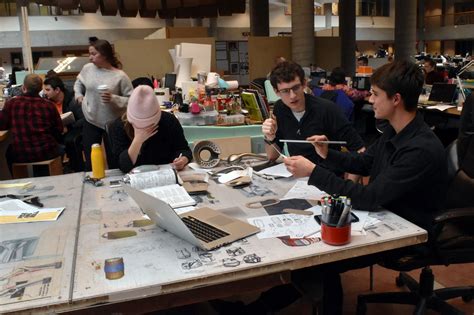The world of industrial design is a fascinating blend of creativity, innovation, and problem-solving. From product design to user experience, industrial designers play a crucial role in shaping the way we interact with the world around us. If you’re considering a career in this exciting field, you’ll want to explore the top industrial design programs offered at universities across the United States. In this blog post, we’ll take a closer look at what sets these programs apart, including the curriculum and courses offered, the expertise of faculty members, internship opportunities, state-of-the-art facilities, student projects, career prospects, and the admissions process. Whether you’re a high school student exploring your options or a professional looking to make a career change, there’s something for everyone in the world of industrial design. And with scholarships and financial aid available, pursuing your passion for design has never been more accessible. Join us as we delve into the world of industrial design programs at US universities.
Table of Contents
Introduction to Industrial Design
Industrial design is a multidisciplinary field that focuses on designing and creating products that are both functional and aesthetically pleasing. It involves the application of design principles, engineering concepts, and manufacturing techniques to develop products that improve the quality of life for users. Industrial designers work on a wide range of products, including consumer electronics, furniture, appliances, and medical devices.
One of the key aspects of industrial design is understanding user needs and preferences. Designers conduct extensive research to gather insights into how people interact with products and identify opportunities for improvement. They then use this information to develop innovative and user-friendly designs that meet the needs of the target audience.
In addition to technical skills, industrial designers also need to have a creative mindset and a strong understanding of market trends. They must be able to think outside the box and come up with original ideas, while also considering factors such as cost, feasibility, and market demand. This blend of creativity and practicality is what sets industrial design apart from other design disciplines.
Overall, industrial design plays a crucial role in shaping the way we interact with the products around us. By prioritizing usability and aesthetics, industrial designers contribute to the development of products that enhance everyday experiences and improve quality of life.
Top Universities for Industrial Design Programs
When it comes to pursuing a career in industrial design, choosing the right university is crucial for your success. With the increasing demand for skilled industrial designers, selecting a top-rated institution can make all the difference in your education and future prospects. Here are some of the leading universities known for their exceptional industrial design programs.
One of the top universities for industrial design programs is the Rhode Island School of Design (RISD). Renowned for its focus on hands-on learning and multidisciplinary approach, RISD offers a comprehensive curriculum that prepares students for the diverse challenges of the design industry. The school’s strong emphasis on creativity, innovation, and critical thinking sets it apart as a top choice for aspiring industrial designers.
ArtCenter College of Design is another prestigious institution known for its outstanding industrial design programs. With a strong emphasis on design thinking, collaboration, and real-world experience, ArtCenter provides students with the tools and knowledge needed to succeed in the competitive field of industrial design.
In addition, the Pratt Institute in Brooklyn, New York, is highly regarded for its comprehensive industrial design programs. With a focus on sustainability, technology, and cultural awareness, Pratt Institute equips students with the skills and expertise to address complex design challenges and make a meaningful impact in the industry.
Curriculum and Courses Offered
When considering a career in industrial design, it’s crucial to understand the curriculum and courses offered at different universities. The curriculum typically includes a combination of core design courses, technical skills training, and theoretical knowledge. Students are exposed to a wide range of subjects such as product design, design thinking, human factors, materials and manufacturing processes, and digital modeling.
Additionally, students can expect to take courses in visual communication, design history, sustainability, and user experience design. The goal is to provide a holistic education that prepares students to tackle real-world design challenges while staying abreast of industry trends and advancements. It’s important to research the specific courses offered by each university to ensure that they align with your interests and career goals.
Some universities may offer specialized courses in areas such as automotive design, furniture design, or medical product design. Elective courses allow students to tailor their education to their specific interests and aspirations within the field of industrial design. Furthermore, many programs incorporate interdisciplinary collaboration, allowing students to work on projects with peers from other design disciplines or engineering programs.
Overall, the curriculum and courses offered play a significant role in shaping the educational experience and preparing students for a successful career in industrial design. Prospective students should carefully evaluate the offerings of various programs to find the best fit for their individual goals and aspirations.
Faculty and Expertise in Industrial Design
When it comes to pursuing a degree in industrial design, the faculty and their expertise play a crucial role in shaping the educational experience. At the top universities for industrial design programs, you will find a team of dedicated and knowledgeable professors who are not only well-versed in the principles of design, but also have real-world experience in the industry. Their expertise extends beyond just teaching the fundamentals of design, as they often bring valuable insights and practical knowledge from their own professional endeavors.
Many industrial design programs pride themselves on having a diverse faculty, comprised of individuals with backgrounds in various design disciplines such as product design, graphic design, and user experience design. This diversity allows students to benefit from a well-rounded faculty who can offer different perspectives and approaches to design problem-solving.
Moreover, it’s not uncommon for industrial design faculty members to be involved in ongoing research, innovation, and collaborative projects within the industry. This means that students have the opportunity to learn from professors who are actively contributing to the advancement of industrial design through their own work, and who can share these experiences with their students in the classroom.
Overall, the faculty and their expertise are a vital component of any industrial design program, and it’s important for prospective students to consider the backgrounds, achievements, and industry connections of the professors when choosing a university to pursue their design education.
Internship Opportunities and Industry Partnerships
Internship opportunities and industry partnerships play a crucial role in shaping the career of industrial design students. These hands-on experiences provide students with the chance to apply their knowledge and skills in real-world settings. Internship opportunities allow students to gain practical experience, build professional networks, and enhance their resume. Through industry partnerships, students have the opportunity to collaborate with established professionals, engage in industry-relevant projects, and gain exposure to the latest trends and technologies in the field.
Moreover, internships and industry partnerships provide students with valuable mentorship and guidance from experienced professionals, allowing them to develop a deeper understanding of the industry and its demands. This experiential learning also enables students to explore different career paths within industrial design and make informed decisions about their future goals and aspirations.
Furthermore, these opportunities often lead to employment prospects, as many companies use internships as a recruitment strategy to identify and train potential employees. By fostering strong ties with industry partners, students can gain access to job openings, references, and mentorship, which can greatly benefit their transition from academia to the professional world.
Overall, internship opportunities and industry partnerships are indispensable aspects of an industrial design program, providing students with the practical skills, industry exposure, and professional connections necessary for a successful career in the field.
State-of-the-Art Facilities and Resources
When considering an industrial design program, it’s important to take a close look at the facilities and resources available to students. State-of-the-art facilities can make a significant difference in the quality of education and the opportunities available to aspiring designers.
At top universities for industrial design programs, students can expect to find cutting-edge workshops and labs equipped with the latest tools and technologies. These facilities provide students with hands-on experience and the opportunity to bring their designs to life.
In addition to physical resources, top industrial design programs also offer access to extensive libraries, research databases, and online resources. These resources play a crucial role in helping students stay up to date with the latest industry trends, techniques, and innovations.
By offering state-of-the-art facilities and resources, universities are able to provide students with the support and tools they need to succeed in the competitive field of industrial design.
Student Projects and Design Competitions
Student projects and design competitions are an essential part of the industrial design program, offering students the opportunity to apply their skills and knowledge to real-world challenges. Through these projects, students can develop their creative and problem-solving abilities while gaining valuable experience working on interdisciplinary teams.
Participating in design competitions allows students to showcase their talents and gain recognition within the industry. Winning or being a finalist in a design competition can have a significant impact on a student’s professional development, providing opportunities for networking and career advancement.
These projects and competitions often serve as a bridge between the academic environment and the professional world, giving students a chance to collaborate with industry partners and explore innovative solutions to contemporary design problems.
Overall, student projects and design competitions are an integral part of the industrial design program, helping students to hone their skills, build their portfolios, and establish themselves as emerging professionals in the field.
Career Prospects and Alumni Success Stories
When considering a career in industrial design, it is important to explore the various career prospects that are available in this field. Industrial designers have the opportunity to work in a wide range of industries, including product design, automotive design, and furniture design. With the rapid advancement of technology, there are also opportunities in the fields of user experience design and design research.
Alumni success stories can provide valuable insight into the potential career paths that are available to graduates of industrial design programs. Many alumni go on to work for prestigious design firms, while others choose to start their own design businesses. Some alumni also pursue further education and research in design-related fields, leading to successful academic and industry careers.
Furthermore, the demand for industrial designers is expected to grow in the coming years, as companies continue to prioritize innovation and user-centered design. This opens up exciting opportunities for recent graduates to enter the workforce and make a meaningful impact in their chosen field. With the right skills and knowledge gained from their industrial design programs, graduates can look forward to a fulfilling and rewarding career.
Overall, industrial design programs not only prepare students with the necessary skills and expertise, but also provide them with a strong network of alumni who have achieved success in their careers. By learning from the experiences and achievements of alumni, current students can gain valuable insights into the potential career paths that are available to them, and be inspired to pursue their own goals in the field of industrial design.
Admissions Process and Requirements
When it comes to applying to a top industrial design program, there are a few key admissions processes and requirements that prospective students must be aware of. The first step in the application process is to submit a completed application form, along with a personal statement detailing your interest in industrial design and your career goals. This is also the time to submit any relevant portfolio of your design work, which will be a crucial aspect of your application.
Additionally, most industrial design programs require applicants to provide letters of recommendation from past teachers or employers who can speak to your skills and potential in the field. Along with this, a transcript of your academic records and grades from previous education institutions will also be needed to be submitted as part of the requirements for admission.
Many universities also require applicants to complete an interview or participate in a design challenge as part of the admissions process. This gives the admissions committee an opportunity to assess the applicant’s creativity, problem-solving skills, and passion for design.
Lastly, it’s important for prospective students to keep an eye on the specific deadlines for admissions and make sure to submit all required materials and documents by those deadlines to be considered for the industrial design program. Meeting these admissions requirements and processes is crucial to securing a spot in the program of your choice and launching your career in industrial design.
Scholarships and Financial Aid for Industrial Design Programs
Aspiring industrial design students often face the challenge of financing their education. Fortunately, there are various scholarship and financial aid opportunities available for those pursuing a degree in industrial design.
Many universities offering industrial design programs have scholarships specifically designed for students within the program. These can be merit-based, need-based, or awarded based on specific criteria such as design portfolio, academic performance, or extracurricular involvement.
In addition to university-specific scholarships, there are also external scholarships and grants available to industrial design students. Organizations, foundations, and companies in the design industry often offer financial aid to support students pursuing a career in industrial design.
Aside from scholarships, students can explore options for loans, work-study programs, and financial aid packages to help offset the cost of tuition and related expenses. It’s important for prospective students to research and apply for all available financial assistance to make their education more affordable.





